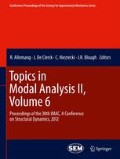Abstract
Torsional vibration signature analysis has shown the potential to detect shaft cracks during normal operation of rotating equipment. The method tracks characteristic changes in the natural torsional vibration frequencies that are associated with shaft crack propagation. The method is generally applicable to many types of rotating equipment. A rotor test bed was developed to investigate shaft cracking detection techniques to investigate the capabilities and limitations under realistic yet controlled conditions. The test bed has a sacrificial shaft mounted between a 35 hp drive and 70 hp load motor. A full suite of torsional and translational vibration sensors are deployed on the test bed. A lateral load can be applied to the rotating shaft via a hydraulic cylinder. A series of seeded fault tests were performed by growing a fatigue crack in the shaft. The crack is grown by rotating the shaft under lateral load to produce full reversal bending stresses. The vibration diagnostic features are acquired and trended as the crack grows. The testing objective is to develop the correlation and sensitivity between the shaft health (i.e., crack size) and the acquired diagnostic features. During baseline testing, before initiation of the fatigue crack, the torsional vibration diagnostic features were observed to be unstable. Further examination showed the torsional vibration diagnostic features were being affected by the laboratory temperature. The paper describes outcomes and observations related to the environmental effects on the shaft health diagnostics in controlled testing. The lab results are discussed in relation to what may be expected and the effect on the torsional vibration diagnostic features in an industrial setting. The controlled laboratory testing results and analysis assists in the interpretation of torsional vibration features for structural health diagnostics.
Access this chapter
Tax calculation will be finalised at checkout
Purchases are for personal use only
References
Papadopoulos CA (1994) Torsional vibrations of rotors with transverse surface cracks. Comput Struct 51:713–718
Lissenden CJ, Tissot SP, Trethewey MW, Maynard KP (2007) Torsion response of a cracked stainless steel shaft. Fatigue Fract Eng Mater Struct 30:734–747
Bieryla DJ, Trethewey MW, Lissenden CJ, Lebold MS, Maynard KP (2005) Shaft crack monitoring via torsional vibration analysis; part 1—laboratory tests. In: Proceedings of the 23nd international modal analysis conference, Orlando, 31 Jan–3 Feb 2005
Maynard KP, Trethewey MW (1999) On the feasibility of blade crack detection through torsional vibration measurements. In: Proceedings of the 53rd meeting of the society for machinery failure prevention technology, Virginia Beach
Trethewey MW, Lebold MS, Gyomlai P, Garrett PW, Guindon EJ (2006) Torsion and translational vibration trending of seeded shaft faults in a 41% reduced scale reactor coolant pump. In: Proceedings of the 7th international conference on rotor dynamics, Vienna, 25–28 Sept 2006
Trethewey MW, Lebold MS, Turner MW (2010) Minimally intrusive torsional vibration sensing on rotating shafts. In: Proceedings of the 28th IMAC, Jacksonville, 1–4 Feb 2010
Trethewey MW, Lebold MS (2009) Identification of torsional vibration features in electrical powered rotating equipment. In: Proceedings of the 27th IMAC, Orlando, 9–12 Feb 2009
Acknowledgements
Portions of this work were supported by the Electric Power Research Institute (EPRI Contract EP-P9801/C4961). The content of the information does not necessarily reflect the position or policy of the EPRI, and no official endorsement should be inferred.
Special thanks to Nathan Lasut for his assistance in the sensor orientation studies.
Author information
Authors and Affiliations
Corresponding author
Editor information
Editors and Affiliations
Rights and permissions
Copyright information
© 2012 The Society for Experimental Mechanics, Inc.
About this paper
Cite this paper
Lebold, M.S., Bednar, J.P., Trethewey, M.W. (2012). Environmental Effects on Torsional Vibration Feature Health Monitoring. In: Allemang, R., De Clerck, J., Niezrecki, C., Blough, J. (eds) Topics in Modal Analysis II, Volume 6. Conference Proceedings of the Society for Experimental Mechanics Series. Springer, New York, NY. https://doi.org/10.1007/978-1-4614-2419-2_31
Download citation
DOI: https://doi.org/10.1007/978-1-4614-2419-2_31
Publisher Name: Springer, New York, NY
Print ISBN: 978-1-4614-2418-5
Online ISBN: 978-1-4614-2419-2
eBook Packages: EngineeringEngineering (R0)

